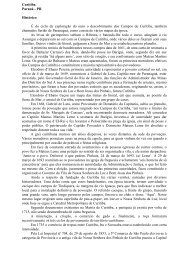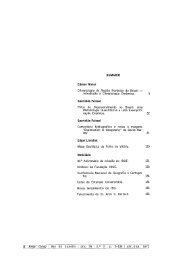REVISTA BRASILEIRA DE GEOGRAFIA - Biblioteca do IBGE
REVISTA BRASILEIRA DE GEOGRAFIA - Biblioteca do IBGE
REVISTA BRASILEIRA DE GEOGRAFIA - Biblioteca do IBGE
You also want an ePaper? Increase the reach of your titles
YUMPU automatically turns print PDFs into web optimized ePapers that Google loves.
ROTAS PIONEIRAS <strong>DE</strong> SANTA CATARINA 813<br />
RIASSUNTO<br />
11 signor OsMAR R. DA SILVA, studian<strong>do</strong> l'influenza delle antiche strade sulla messa in<br />
coltura, sul popolamento e su!Io sviluppo economico di Santa Catarina, indica !e caratteristiche<br />
delle principali strade :<br />
1.a) Da S. Francisco a Curitiba. In un tratto di questa strada, che sale per i monti, prohabilmente<br />
passõ Cabeça de Vaca nel suo viaggio a! Paraguai. Questa strada costituisce la<br />
comunicazione piú settentrionale tra la costa e I'altopiano; per essa penetrarono gli elementi<br />
colonizzatori forestieri.<br />
2.o) Da S. Francisco a Desterro (attuale Florianópolis). E' stata sostituita da!Ia navigazione<br />
costiera.<br />
3.0) Da S. José a Lajes. La. funzione coordinatrice di questra strada non diminui d'importanza<br />
co! tempo; essa, anzi, servi alio Stato di Santa Catarina per ricuperare i! <strong>do</strong>minio di una<br />
vasta regione, Ia cui vita economica, politica e sociale si era orientata verso il Rio Grande.<br />
Perciõ, Iungo questa strada si formarono nuclei sociall, che contrassegnano la sua influenza sul<br />
popolamento. Costituisce oggi una delle linee piú importanti della rete stradale di Santa Catarina.<br />
4.0) Da Laguna a Viamão. Si stende lungo la spiaggia. Venne utilizzata fino a che cedette<br />
la sua funzione alia strada seguente. ·<br />
5.0) Strada dei conventqs. Unisce i! littorale meridionale all'alto-piano, nel punto in cui 1<br />
contrafforti della Serra <strong>do</strong> Mar s'innalzano piú scoscesi, forman<strong>do</strong> vere murag!ie, con poche<br />
gole, entro le qual! si insinua la strada. Questa fu aperta da Souza Faria, e migliorata da<br />
Cristovam Pereira de Abreu, che !'inauguro nel 1731, guidan<strong>do</strong> 800 capi di bestiame da Rio<br />
Grande a São Paulo.<br />
6.0) Strada delle mandre. Univa Viamão con Sorocaba. Tra Curitibanos e Campo <strong>do</strong> Tenente,<br />
nel Paraná, fu anche denominata "Strada della foresta", perché in queltratto attraversava densi<br />
boschi. Probabilmente fu la via che seguirono i pionieri "Bandeirantes", quan<strong>do</strong> si spinsero verso<br />
i! Sud. L'importanza di essa per lo svíluppo dell'interno dello Stato di Santa Catarina é dimostrato<br />
dai numerosi villaggi che s'incontrano fino a S. Joaquim: come S. Lourenço, Butia,<br />
Saltinho, Estiva; ed altri, i cui nomi rivelano !'origine da attività pastorali, come Rodeio<br />
Grande, Campo Alto, Passo Canoinhas, Rancho Grande, Passa Dois, e altri. Da Curitibanos a<br />
Mafra !e distanze che separano i villaggi corrispon<strong>do</strong>no al cammino giornaliero delle mandre,<br />
perché ognuno di essi deve aver corrisposto, da principio, a un posto di riposo e di fermata<br />
o di pascolo. Questa strada, che apri nuovi orizzonti per i! suo orientamento verso Sud, fu per<br />
molti anui un fattore di unificazione nazionale; oggi perõ é piú importante a questo fine la<br />
strada da S. José a Lajes.<br />
Conclude l'autore che, "ecoottuate !e zone fluviali, tutte le altre regioni pioniere corrispon<strong>do</strong>no<br />
ai punti di partenza, alle parti intermedie o ai punti di arrivo delle nostre strade storiche."<br />
SUMMARY<br />
Mr. OsMAR R. DA SILVA, during his studies on the influence of roads in the opening up Óf<br />
the State of Santa Catarina and in its settlement and ultimate economy, pointed out the<br />
principal ones, with their respective characteristics.<br />
l.O) The road from São Francisco to Curitiba, along part of which, for climbing the<br />
mountain chain, Cabeza de Vaca probably passed on his journey to Paraguay.<br />
It is the southernmost road in the State joining the coast to the tableland, by which the<br />
foreign colonizing elements penetrated.<br />
2.0) São Francisco to Desterro, now Florianopolis, which has been superseded by coastwise<br />
navigation.<br />
3.0) s. José to Lajes, which has not lost its co-ordinating function with the passing of<br />
the years.<br />
on the contrary, it was the main factor in the recovery by the State of Santa Catarina<br />
of the vast region, whose economic, political and social life used to be inclined towards Rio<br />
Grande. For that reason, along its course arose social settlements with marked populating<br />
influences. To-day it has become one of the most important in the State's chain of highways.<br />
4.") Laguna to Viamão, along the beach. This was used before the road next mentioned<br />
became known.<br />
5.0) caminho <strong>do</strong>s Conventos, or Convent Road, which joined the southern coast to the<br />
tableland, where the ramparts of the Serra <strong>do</strong> Mar were steepest, like massive stonewalls with,<br />
here and there, a gorge, through which wound the road opened by Souza Faria, !ater improved<br />
by Cristovam Pereira de Abreu, who inaugurated it in 1731 with 800 head of cattle brought from<br />
Rio Grande to S. Paulo.<br />
6.0) caminho das Tropas, from Viamão to Sorocaba.<br />
Between Curitibanos and Campo <strong>do</strong> Tenente, in Paraná, it also received the name of Estrada<br />
da Mata or Jungle Road, as it passed through dense forests in this section. It was probably<br />
the road' followed by the pioneers, or "bandeirantes", in their drives "t9 the Soüth.<br />
The importance of this highway in the development of the hinterland of S. Catarina becomes<br />
evident by the string of settlements which extend as far as S. Joaquim, such as S. Lourenço,<br />
Butiá, Saltinho, Estiva, besides . those whose names betray their cattle origin, like Rodeio<br />
Grande, campo Alto, Passo Canomhas, Rancho Grande, Passa Do1s and others.<br />
From curitibanos to Mafra the distances between the settlements represent a day's march<br />
of the settlers, so that each must have been originally a stopping place for rest or grazing.<br />
owing to its plan in the ~ame direction as the other southern roads, this ploneer highway<br />
was, during many years, a factor of natio';lal unity. Now,_ however, it competes with two<br />
others from s. José to Lajes, for supremacy, 1n accordance Wlth the concludlng remarks of the<br />
autho; who reminds us that "with the exceptlon of regions served by rivers, ali the other<br />
plonee; zones correspond exactly to the starting, intermediate or terminal points of our historical<br />
highways".<br />
Pág. 45 - Outubro-Dezembro de 1941


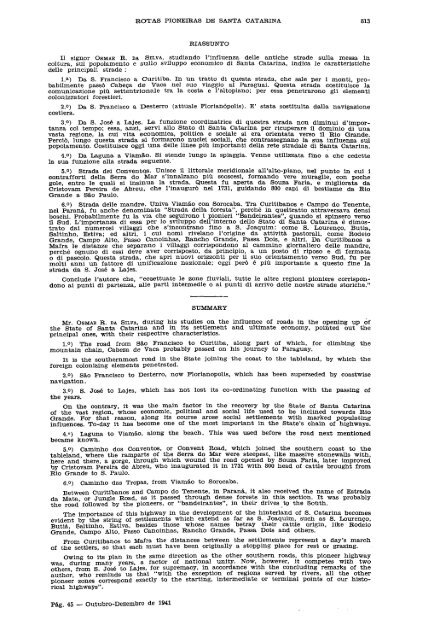
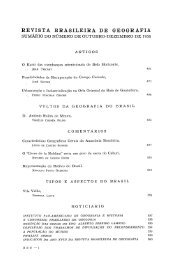
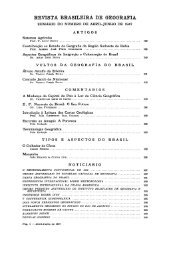



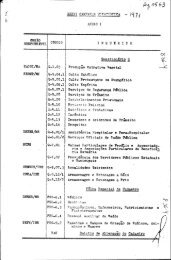
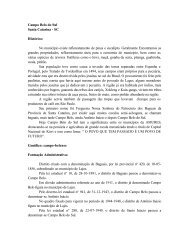
![Manual de Estatística [Fillippo Virgillii] - Biblioteca do IBGE](https://img.yumpu.com/17097551/1/185x260/manual-de-estatistica-fillippo-virgillii-biblioteca-do-ibge.jpg?quality=85)

